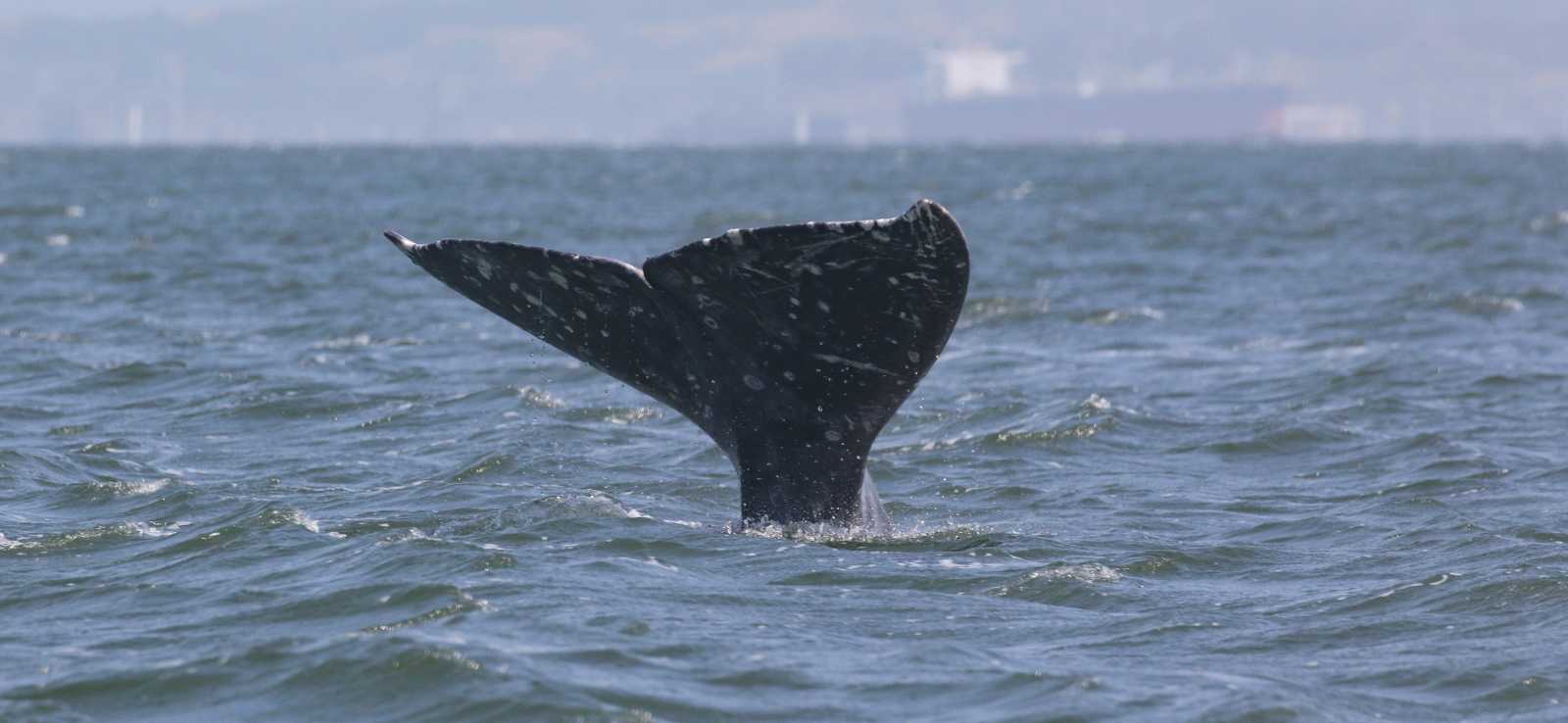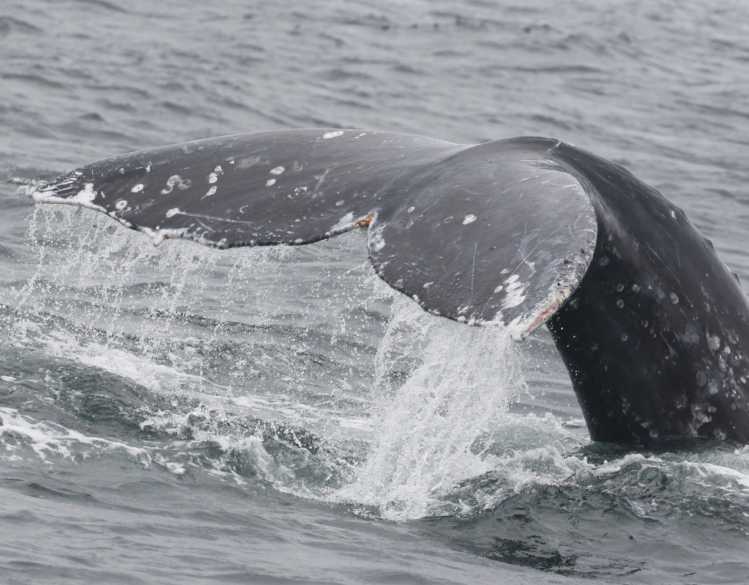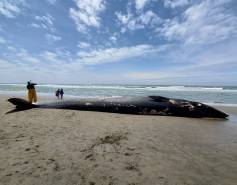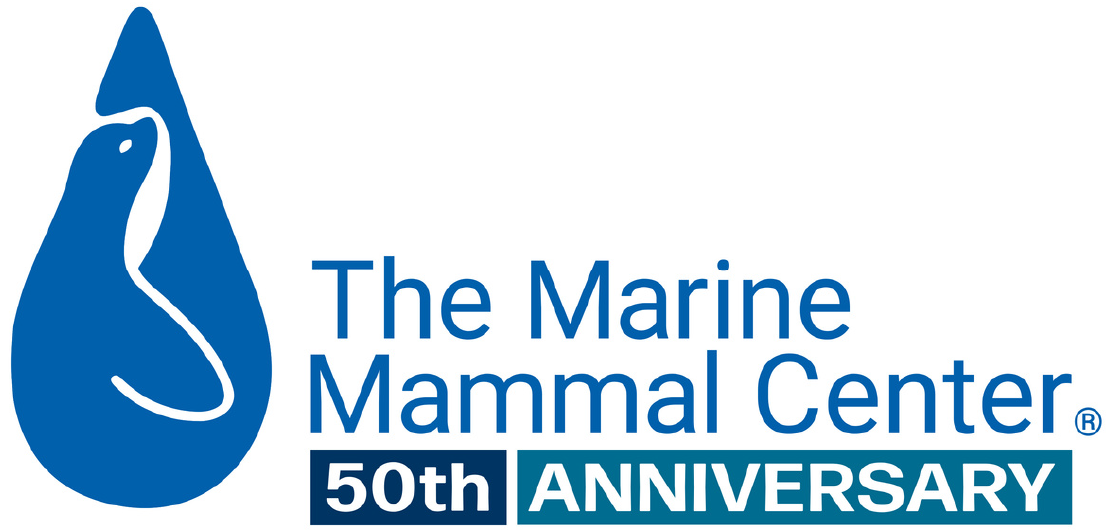
Photo-Identification Field Research: Meet the Whales
The Marine Mammal Center is a leading organization studying cetaceans—whales, dolphins and porpoises—in San Francisco Bay, resulting in a robust collection of data.
Through boat-based and shore-based data collection, our Cetacean Conservation Biology program is compiling the first-ever humpback whale, gray whale, harbor porpoise and bottlenose dolphin photo-identification catalogs for the San Francisco Bay. This photo-identification research allows us to better understand human impacts on cetaceans, inform proactive solutions and take action to protect these animals.
Dive into the photo-identification catalog below to meet the individuals our experts have sighted along the California coast.
About Gray Whales (Eschrichtius robustus)
Seasonal sightings of several gray whales in the San Francisco Bay are a relatively recent phenomenon. For more than two decades, gray whales have been seen temporarily passing underneath the Golden Gate Bridge two to three times per season. Sightings of these animals dramatically increased in 2018 as the population made their springtime northerly migration. At the time, many gray whales were in poor body condition and washed ashore along their migration route at an alarming rate. This prompted the National Oceanic and Atmospheric Administration (NOAA) to declare an Unusual Mortality event (UME) for the species, which ended in 2023.
As we continue to actively monitor gray whales in our area, researchers are still observing seasonal influxes of these animals in the San Francisco Bay as the population passes through during their migrations from Mexico to Alaska and back again.

Semi-colon
Years Sighted: 2021, 2022, 2023, 2024, 2025
Sighting Areas: Farallon Islands, Pacifica, San Francisco Bay
This individual was named after a distinct marking on its right side that resembles a semi-colon. First sighted at the Farallon Islands in summer 2021, Semi-colon has returned to the San Francisco Bay each spring. This whale is one of just seven individuals that were observed in 2022 in Pacifica feeding on fish, a behavior rarely seen among gray whales. Known as TMMC-5 in our research paper documenting this event, Semi-colon was observed using a side-swimming technique to feed on anchovy as well as a more typical method of sucking up mud to filter out small creatures such as crustaceans and worms.
Morse
Years Sighted: 2023
Sighting Areas: San Francisco Bay
This individual holds the record for the furthest north into the San Francisco Bay that a whale has been identified. First sighted in March 2023, Morse is easily identifiable by the large dots and dashes on its sides that resemble Morse code. After initial sightings, this individual was not seen again until November 2023. In San Pablo Bay, Morse was sighted by a local tour group with some new markings, scars caused by a propeller injury. Morse’s injuries highlight that whales interact with vessels more frequently than mortality rates alone suggest. This is why we must continue critical efforts to protect whales, such as supporting best practices, informing management actions like vessel speed restrictions and improving real-time whale location reporting in the San Francisco Bay region.


Luna
Years Sighted: 2023
Sighting Areas: San Francisco Bay, Point Reyes National Seashore
This individual is named for the crescent moon shape on the side of its tail. Often seen mid-Bay between Angel Island, Treasure Island and Alcatraz Island, Luna was observed for more than a month in San Francisco Bay. Luna’s last sighting in this area was May 2023, but our researchers came across this individual during an offshore survey about one month later. Luna was traveling north near Point Reyes National Seashore. Experts believe Luna was migrating to arctic waters where gray whales feed in the summer months.
Oreo
Years Sighted: 2023
Sighting Areas: San Francisco Bay
At 55 days from the first to last sighting, Oreo holds the record for the second longest period an individual whale has been observed in San Francisco Bay. First identified by one of our volunteers while shore-spotting, Oreo was photographed on 18 different days in 2023 by our researchers and local whale-watching naturalists. This individual was often seen with mud plumes, indicating potential feeding behavior. This is also one of the only individuals observed lifting its flukes out of the water regularly, an additional indication of deeper dives to feed. Oreo is another whale that was frequently observed mid-Bay between Alcatraz Island, Angel Island and Treasure Island.


Angle
Years Sighted: 2023
Sighting Areas: San Francisco Bay
Known for its characteristic scar, Angle is an easily identifiable whale that was observed for more than a month in San Francisco Bay. Angle was seen in the Golden Gate Strait, the waterway underneath the Golden Gate Bridge, indicating that this individual may have left the Bay and come back. Angle was also often seen in Richardson Bay near the Sausalito sewage treatment plant, an area our experts believe was one of Angle’s preferred spots. Sometimes outfalls from sewage treatment plants can be full of nutrients and stimulate prey growth in the surrounding area. Mud plumes were observed on several occasions, so experts believe Angle may have been taking advantage of this and feeding nearby.
Paws
Years Sighted: 2022
Sighting Areas: Pacifica, Stinson Beach
This whale clearly likes anchovies as it has been seen foraging in two different locations for them. Known as TMMC-1 in our research paper highlighting feeding and foraging behavior, Paws is one of seven whales observed in June 2022 during a phenomenon feeding event. We observed Paws side-swimming through schools of fish near the surface and sediment streaming to filter prey such as crustaceans and small worms from the muddy bottom. Later that summer, Paws was seen swimming through large groups of anchovies off Stinson Beach. Gray whales have shown themselves to be flexible, opportunistic feeders.


Galaxy
Years Sighted: 2022
Sighting Areas: Pacifica, Stinson Beach, Vancouver Island, Northern California Coast
Known as TMMC-2 in our research paper highlighting feeding and foraging behavior, Galaxy is a well-known whale to other research groups as its initial sighting dates back to 2005. While seen primarily in Northern California, Galaxy has also been sighted as far north as Vancouver Island, Canada. Our partners at Cascadia Research Collective have identified Galaxy as a member of the “Pacific Coast Feeding Group,” a subset of the eastern North Pacific gray whale population. This small group of whales is known to spend the summer foraging in Northern California through British Columbia instead of completing the entire migration further north to the Bering and Chukchi Seas.
Wave
Years Sighted: 2022
Sighting Areas: Pacifica
This whale was hungry! Of all the behaviors researchers observed during the 2022 Pacifica feeding event, Wave’s feeding amounted to roughly half. Known as TMMC-3 in our research paper highlighting feeding and foraging behavior, Wave is an easily identifiable whale by the wave-shaped marking along its left side. This gregarious individual was the most prolific forager observed during the Pacifica feeding event, making up 52 percent of all behaviors observed. Wave was seen lunging at the surface to intake as many anchovies in one movement as possible, a behavior often seen in other large whales but rarely seen in gray whales.


Peach
Years Sighted: 2022, 2024
Sighting Areas: Pacifica, San Francisco Bay
This whale was first identified by our researchers in Pacifica and later seen by whale-watching naturalists and our researchers in San Francisco Bay. Known as TMMC-7 in our research paper highlighting feeding and foraging behavior, Peach was present at the Pacifica feeding event in June 2022. This whale was observed feeding both on fish and on crustaceans in the muddy sea floor surrounding Pacifica Pier. It was a pleasant surprise for our researchers to encounter this whale for a few days in April 2024 in San Francisco Bay. Resighting individuals from year to year helps our experts better understand the patterns and longevity of this species along the California coast.
Asher
Years Sighted: 2024
Sighting Areas: San Francisco Bay, Bolinas Beach
A potential first-time visitor to San Francisco Bay in 2024, Asher was observed in the area for about two weeks. Shortly after its last sighting in the Bay, this whale was seen by our cetacean expert while she was surfing at her favorite spot, Bolinas Beach. She observed the whale seemingly resting as it slowly surfaced once every five minutes in the same spot for about an hour before traveling offshore. This individual may have used San Francisco Bay as a rest stop on its migration north.

Cetacean Research at The Marine Mammal Center
The Marine Mammal Center is at the forefront of research on whales, dolphins and porpoises and has published a number of scientific papers covering a range of topics from biology to conservation threats.
{"image":"\/Animals\/Wild\/Other species\/cropped-images\/fin-whale-fort-funston-by-barbie-halaska-c-the-marine-mammal-center-259-328-3782-2954-1619455378.jpg","alt":"","title":"Analyzing Stress and Reproductive Steroid Hormones in Gray and Fin Whales","link_url":"https:\/\/www.marinemammalcenter.org\/publications\/analyzing-stress-and-reproductive-steroid-hormones-in-gray-and-fin-whales","label":"Research Paper","type":"publication"}

{"image":"\/Animals\/Wild\/Other species\/cropped-images\/stejnegers-beaked-whale-photo-c-marc-webber-0-0-949-742-1618440217.jpg","alt":"Stejneger's beaked whales","title":"Stejneger's Beaked Whale Strandings in Alaska, 1995\u20132020","link_url":"https:\/\/www.marinemammalcenter.org\/publications\/stejnegers-beaked-whale-strandings-in-alaska-1995-2020","label":"Research Paper","type":"publication"}

{"image":"\/Animals\/Wild\/Blue whale\/cropped-images\/blue-whale-aerial-shutterstock-2142-422-3258-2545-1717613306.jpg","alt":"blue whale seen from above","title":"Assessment of Wound Healing of Tagged Gray and Blue Whales Using Photographs","link_url":"https:\/\/www.marinemammalcenter.org\/publications\/assessment-of-wound-healing-of-tagged-gray-and-blue-whales-using-photographs","label":"Research Paper","type":"publication"}

Assessment of Wound Healing of Tagged Gray and Blue Whales Using Photographs
Read More{"image":"\/Animals\/Wild\/Gray whale\/cropped-images\/gray-whale-necropsy-by-katie-dinnocenzo-c-the-marine-mammal-center-161-0-3871-3023-1604437583.jpg","alt":"researchers perform a necropsy on a dead gray whale on the beach","title":"Gray Whale Post-Mortem Findings During the Unusual Mortality Event in the Eastern North Pacific","link_url":"https:\/\/www.marinemammalcenter.org\/publications\/gray-whale-post-mortem-findings-during-the-unusual-mortality-event-in-the-eastern-north-pacific","label":"Research Paper","type":"publication"}

Gray Whale Post-Mortem Findings During the Unusual Mortality Event in the Eastern North Pacific
Read MoreYou Can Make a Difference
The Marine Mammal Center is committed to learning more about human impacts on whales, dolphins and porpoises, and taking action to protect them. Support from people like you makes this life-saving research possible. You can be part of the solution and make a real difference for marine mammals in distress with a gift today.










